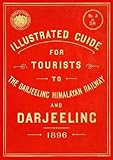Darjeeling Himalayan railway: illustrated guide for tourists
Material type: TextPublication details: London: Pagoda Tree Press, 2005Description: 46 p.: ill., folded mapsISBN: 1904289037Subject(s): Travel & Transportation -- Darjeeling Himalayan Railway | Tourism -- Tours & Tourists | Travel Guide | Darjeeling, India -- Himalayan RailwayDDC classification: 910.2025414
TextPublication details: London: Pagoda Tree Press, 2005Description: 46 p.: ill., folded mapsISBN: 1904289037Subject(s): Travel & Transportation -- Darjeeling Himalayan Railway | Tourism -- Tours & Tourists | Travel Guide | Darjeeling, India -- Himalayan RailwayDDC classification: 910.2025414 | Item type | Current library | Call number | Status | Date due | Barcode | Item holds |
|---|---|---|---|---|---|---|
|
|
Central Library, Sikkim University General Book Section | 910.2025414 DAR/T (Browse shelf(Opens below)) | Available | P24934 |
First edition was originally published in 1896 by Darjeeling-Himalayan Railway Co., Darjeeling India.
Chapter I.—OW route via Carragola. Present route. Ferry transit Sara Ghat Eastern Bengal State Railway. Silliguri. Miniature engine of the Darjeeling Himalayan Railway. The track. The locomotives and carriages. Hints for travellers' comfort
Chapter II.;—History of this mountain railway. Sir Ashley Eden, K.C.S.I. his support First attempt at "private enterprise." Lord Lytton's trip on the line. Opening of line. Capital of the line. The hill cart road. Advantages of the railway for reaching a health resort, and for trade.
Chapter III.—Country traversed by the Darjeeling Himalayan Railway. History of British Sikhim. Dr. Hooker's imprisonment.
Chapter IV.—Description of some of the races inhabiting British Sikhim.
Chapter V.—Start from Silliguri. Sookna. Rivws. The jungle. The wild animals of the Terai. Panchkeela. Rapid rise. Sharp curves. First spiral or loop. Second and third loop. View of Teesta River. Zigzag or reverse. Teendaria Company's workshops.
Chapter VI.—Leaving Teendaria. Another zigzag. Fourth spiral. Sitong Hill. Mahaldiram Ridge. 23rd mile zigzag. Lepcha monuments, fourth zigzag. Pagla jhora. 25 1/4 mile: "The Ghoomtee" Waterfall. Artilleryman's Point Kurseong: "Eagle's Craig." View of the Plains.
Chapter VII.—Kurseong. Old road from Punkabaree. Old road to Senchal. Church. Dak Bungalow. Schools. Hotel. -Views from the hotel. Tea Gardens: "Singell," etc. Rest Barracks. Maharajah of Burdwan's Rest House. -Hope Town. Farming and gardening, etc.
Chapter VIII,—Kurseong to Darjeeling. Sonada. Hope Town, Jore Bungalow Bazaar, Ghoom Station, the highest point reached by the railway. Snow plough in India, Arrival at Darjeeling.
Chapter IX—Town of Darjeeling, The Lieutenant-Governor's residence. The Eden Sanitarium, The Club, Amusements, Town Hall, Mall, Church, Schools, Hotels and Boarding Houses. People's Park, Botanical Gardens. Walks, rides, etc, Bhootea Bustee. Bhooteas, Lamas, Prayers, Curios,
Chapter X—Jellapahar Invalid Depot Roads, Ghoom Rock. Botanical Garden, Rangaroon, Cinchona plantations.
Chapter XI—The Snows, Sunrise on Senchal. Mount Everest. Site of old barracks. Water supply of Darjeeling, Observatory Hill, Chapter XII,—Manufacture of tea. Cultivation of tea. Discovery in 1826 in Bengal. Number of gardens, and out-turn.
Chapter XIII—Places for excursions, Nepal Frontier. Tongloo. Phalut. Junction of Teesta River. Suspension Bridge.
Chapter XIV.—Conclusion, Technical part of the railway. Index section. Speed. No accidents. Difficulties due to rainfall. Loop No 2. Reverse, 18th mile, Curves, 40th mile.


There are no comments on this title.